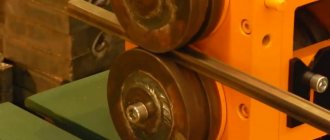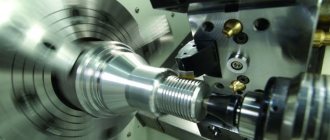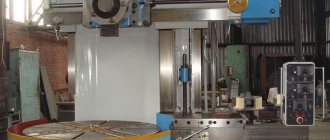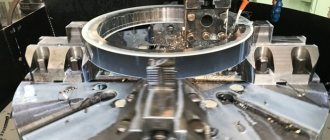Houses, cottages, log houses, bathhouses made of rounded wood are always popular. High-quality wood processing is carried out on special machines that make it possible to obtain a log of the same diameter along the entire length.
The latest models of rounding machines perform a number of other functions, but for simple operations you can make such a unit with your own hands.
Functions
The main function that any rounding machine has is the processing of logs as a body of revolution by milling. But to assemble a log house, simply cylindrical blanks are not enough. And in this case, additional equipment capabilities will come to the rescue:
- excavation of grooves to form various locking connections;
- production of parquet dies, timber;
- sawing of linear products;
- sawing timber into carriages and then into edged boards;
- all stages of log rounding, from roughing to final;
- removal of mounting bowls and compensation grooves.
In this case, the log itself is not reinstalled, but cutters and individual components are changed during the work. The result is parts with a wide range of diameters. The limitation concerns the length of the processed logs: the sleds are designed for seven-meter workpieces. A skillful combination of cutters and working techniques allows you to produce complex wooden structures.
Purpose and specifics of equipment
The technology for constructing house buildings from solid logs involves performing a number of operations necessary to prepare the wood for high-quality assembly of the log house.
The universal functions of the rounding machine make it possible to carry out preliminary and finishing processing of round timber during the construction of wooden houses. The wide capabilities of the machine for rounding logs allow you to perform almost a full range of work with a single installation of a wooden workpiece. The resulting element does not require additional processing and is fully ready for the assembly of the log house. The universal unit is capable of consistently performing work from debarking cut timber to selecting mounting grooves:
- removing a layer of tree bark;
- cylindering;
- creating grooves, cutouts of simple and curly shapes;
- production of longitudinal recesses and profile edges.
The machine can be used for finishing timber, processing sawlogs; it can easily cope with wood that has a curvature in shape and a high degree of knottiness. The unit operates on the turning-milling principle and performs work automatically, in accordance with the parameters specified by the operator.
Device
The installation has several main components. The bed is made in the form of a metal frame. It can have a rigid welded connection in the form of a rectangular pipe or a mobile connection of individual metal elements using bolts and nuts. It is the basis for fastening all structural elements.
The rounding machine contains guides along which the sawing tool moves. They usually form a single structure with a metal frame. In certain types of installations, the log moves along guides.
There may be one or two (front and back) headstocks. Their purpose is to secure and twist the log. On the headstock in some models of machines there is a dividing head, which serves to set a certain angle of rotation for different stages of processing.
The unit for fastening tools and moving mechanisms is a caliper.
The main purpose of the cutter is to fasten the cutting tool. It also provides reduced vibration, increased accuracy of operations and ease of entry into the workpiece. There are shaped and universal cutters.
The knives of the rounding machine are made of high grade steel. The cutting tool is attached to the cutter so that it can be easily replaced or removed for sharpening.
In addition, additional elements are installed. These are levers that make it easy to install the workpiece on the frame, and stop rollers that prevent it from sagging. There are also brakes and a carriage lock. They are used in machines with the function of removing the crown bowl and are installed at the end of the carriage. To excavate a longitudinal groove, a log rotation regulator is used.
Modern manufacturers of woodworking equipment equip such rounding machines with automated computer-controlled modules.
Features of modern industrial models
The main feature of machine models produced by well-known manufacturers today is the use of a laser pointer to control the movement of the carriage. This point determines high processing accuracy and the ability to carry out the entire process without reinstalling the workpiece. Thus, a CNC-controlled carriage with a set of tools moves along guides and performs various types of operations.
Log rounding machine
As practice shows, you can make a model with your own hands that will have manual control and the ability to process workpieces up to 7 meters long.
Classification
Experts propose to classify rounding machines according to five parameters:
- type of mechanism;
- the method of moving the log;
- level of automation;
- drive power type;
- diameter of the workpiece used (minimum – 80 m, maximum – 500 m).
Two types of mechanisms are used in installations. The first is a pass-through (rotary) one, which allows you to continuously move the wood through the cutter. The second is cyclic (turning), in which processing is performed by repeating a cycle of actions.
If cyclic actions are performed by a cutting tool, the machine is classified as a cyclo-pass type, and if a log moves, it is classified as a cyclo-positional type. In the mechanisms, logs have the ability to both rotate and move rectilinearly along the guides.
Types of machines
The cost of a rounding machine is based on the power of the device and the availability of additional options to increase the speed and comfort of work. In the simplest equipment modifications, the workpiece is moved manually, but usually a motor drive is installed for this purpose. The carriage speed can reach up to 14 m/sec. Rounding the workpiece in different models takes from 10 to 15 minutes, and when completely processing a log, the time required is about half an hour. Properly organized operation of the machine ensures a finished product output of 100 linear meters per shift.
The equipment has significant power and weight, therefore, before buying a rounding machine, you should make sure that you have a 380-volt power supply and prepare a level area with a concrete base that will compensate for vibration and reduce the noise of the unit during operation. The performance of the device is determined by the modification that allows the number of working operations to be performed and the quality of the wood processed.
Recommendations before purchasing
For the chosen level of productivity, it is important to consider the degree of automation of the rounding machine.
In mechanized models, the operator loads and unloads logs, configures and adjusts the mechanisms. He also monitors the quality of work performed at all stages of operations.
In automated rounding machines, the specialist servicing it is assigned the role of process controller.
In semi-automated installations, the master joins the process after the machine has completed one cycle of operations.
Note! To create optimal and uninterrupted operating conditions, it is important to select the appropriate type of drive power supply.
Electric can work without interruption, provided that the power lines are reliable or there is an additional power generator. Gasoline requires constant refueling, but does not depend on external factors.
But the main choice is between pass-through and loop types. The pass-through will provide high productivity, sometimes at the expense of the quality of processing. Most models of such machines do not have the ability to make the surface of the log smooth, without burrs and roughness. Cyclic installations work much slower, but at the same time they have a number of advantages:
- provide very high quality processing;
- perform the entire set of operations;
- have compact dimensions;
- The design is stable and easy to maintain.
In addition to all of the above, price, equipment manufacturer and required processing quality play an important role.
Milling logs for a log house
Log milling
After forming a flat plane, it is necessary to change the standard configuration of the workpiece. The technology for constructing a log house consists of installing logs on top of each other. As a result, there should be no cracks or sudden changes in wall thickness.
To solve this problem, it is necessary to use a specially shaped cutter, which is installed in the moving part of the machine. Unlike band or disk cutting, it should form not a flat, but an oval notch on the mounting part of the workpiece. Thanks to this, the log house will have optimal wall thickness characteristics, which will affect the degree of thermal insulation.
Stages of milling logs for a log house.
- Rounding. In this case, the cut of the workpiece should have a perfect round shape.
- Calculation of the thickness of the recess to form the mounting groove.
- Choosing a cutter.
- Processing of the log, secondary checking of its geometric dimensions.
But even after this work has been carried out, it is still impossible to erect a log house. A final machining step will be required to create the mounting grooves.
The choice of cutting tool for a log house directly depends on the type of wood. Its hardness, number of knots and geometric dimensions are taken into account.
Offers for professional work
On the woodworking equipment market there are offers of any price category and for different technical needs. The most popular models are “Sherwood”, “Termite”, “Cedar”, “Taiga”, “Terem” with a full range of functions.
Technical characteristics are presented in the table.
| Model | Log length, mm | Diameter range, mm | power, kWt | Time to process one log, min |
| "Sherwood OF-28C" | 5950–6150 | 200–400 | 7,5 | 15–30 |
| "Termite 280OU" | 6200 | 160–280 | 22 | 30–40 |
| "Kedr OS-100" | 6200 | 160–240 | 7,5 | 15–30 |
| "Taiga OS-2" | 6200 | 160–240 | 9,8 | 30–40 |
| "Terem 8000V" | 8100 | 160–400 | 2,6 | 30–40 |
Where to start producing log rounding
A log rounding workshop can be located in a production room, a hangar, or even just under a canopy. The equipment must be protected from the sun and precipitation. Wood blanks and the final products themselves are quite larger in size. The equipment for working with them is also impressive in size. This must be taken into account when choosing premises for production.
The workshop is subject to fire safety requirements. Floors and walls are finished with fireproof materials. The drying chamber is usually installed in a separate room. Blanks and finished products are stored separately. In addition, it is necessary to arrange office space for the administration.
Depending on the volume of production, you need to calculate the required number of workers. In one shift, 3-4 people can handle the rounding of logs at the site. From the administration you will need a director, an accountant and a sales manager.
Operating principle
Rounding is possible for raw materials that meet the following requirements:
- The difference between the diameters of the log in its apical part is no more than 20 mm greater than the transverse size of the finished product;
- The relative humidity of wood should not exceed 20-22%;
- The relative curvature of the workpiece cannot be more than 1%;
- The deflection of the original log should be less than 60 mm per linear meter of the workpiece.
Rounding machines implement one of the three processing technologies described below:
- Classical, in which the product rotates in the centers, and material is removed by radial feed of a rotating cutter mounted on a spindle.
- Longitudinal, when the product is stationary, and only the spindle with a fixedly fixed cutter rotates.
- Roller, when wood is removed by a rotary head that rolls along a generatrix.
In the first case, to perform the required operation, the initial workpiece is clamped in the centers, for which the raw material must undergo preliminary trimming. As a result of this operation, the ends of the workpiece are made perpendicular to the longitudinal axis of the log, and the inevitable unevenness of the cut is eliminated. With this method of rounding, the final result is possible with any initial curvature, however, the greatest waste of wood is expected, and cutting of fibers (the greater the curvature, the more likely it is) leads to the appearance of stress concentrators and deterioration in the durability of the log house.
When implementing the second option, the work of the cutter becomes more complicated, since constantly changing lateral loads reduce the fatigue strength of the woodworking tool. Therefore, developers of such equipment focus on the production of automatic rounding machines. The automatic spindle control constantly monitors the distance between the axis of the workpiece being processed and the working surface of the cutter, and in the event of unacceptable fluctuations between these parameters, it either turns off the machine or adjusts the trajectory of the spindle. If the starting material has significant curvature, the rounded semi-finished product may have ledges.
The tools of roller machines for rounding logs have the greatest durability. Rolling over the surface of the original workpiece, roller cutters ensure uniform wood removal, regardless of fluctuations in transverse dimensions. In addition, simultaneously with the main operation, accompanying transitions can also be performed, for which it is enough to provide for the installation of an additional pair of cutting rollers. The disadvantage of the scheme is that during roller rounding the initial defects (in particular, curvature) are not eliminated. However, it is precisely this kind of rounding equipment that provides the highest yield of usable wood, and is therefore suitable for processing lumber in increased volumes.
At the same time, with a limited scale of processing, machines of the first or second types gain advantage, as they are easier to operate.
Constructions
Single-spindle machines are capable of only rounding, and therefore in woodworking they are gradually being replaced by more functional double-spindle designs. Modern models of this type of equipment include the following components:
- Frame-type bed (often non-separable, which increases rigidity).
- Drive unit.
- The gearbox from which the spindle and the front center are controlled (the rear center is used to support the log).
- A faceplate with a set of cutters (usually one finishing and one roughing, as well as a tool for milling a longitudinal groove).
- Engagement clutch.
- Feeding mechanism.
- Anti-vibration device.
- Feed rollers or conveyor.
- Guides that prevent the product from twisting during processing.
- Control nodes.
A feature of any rounding machine is the high complexity of preparatory and final operations. Despite the presence of feeding and orienting devices, filling the semi-finished product into the center takes a lot of time. Therefore, a number of models of the corresponding equipment are produced with a pair of working faceplates. Their modular layout and independent drive make it possible to round the previous workpiece during installation and positioning. The faceplates are switched using a clutch.
The main production cycle of pass-through cylinder machines is as follows. Before starting work, the necessary cutters are installed in the working carriages, the choice of which is determined by the hardness of the wood, the tool feed speed and the cutting depth. If there is an automated control system (necessary for different configurations of the longitudinal groove along the length of the log), the desired program is installed.
Using a chain drive equipped with locking pins, the workpiece with the required gap is fed into the receiving zone (the size of the gap depends on the feed speed of the cutter and the relative humidity of the material). If there is increased curvature of the workpiece, upper fixing rollers are provided that do not allow it to slip out of the centers. Rollers are also used for rounding workpieces of extreme length.
When the feed mechanism is turned on, the faceplate with cutters is brought to the log, and first the roughing cutter is put into operation, and then the finishing cutter. After milling in one pass, the headstock rotation mechanism is turned off, and the longitudinal milling mechanism comes into operation, which makes a longitudinal groove.
After rounding, the finished product is placed on a transfer platform, from where it is removed using a pushing plunger. The site usually has the ability to reset the dimensions according to the size of the products being processed.
Rounding machines are produced in a modular configuration. When ordering, the composition of the initial and final modules is usually indicated, and then the number of intended intermediate modules. Also stipulated:
- Length, height and angle of inclination of the receiving conveyor, these parameters are changed using side limiters;
- Dimensions of chain sprockets;
- Set of drive gears of the feed box;
- Need for additional drive motors.
The technological cycle of processing timber on roller-type machines is as follows. Setting up such machines consists of installing and debugging the number and configuration of pairs of working rollers with which cylindering is performed. Typically, the length of the axis is such that up to 5-6 pairs of rollers can be installed, which not only roll and remove material, but also support the workpiece during processing. The produced chips are conveyed through guide grooves to a blade-type grinding unit, which turns the chips into small chips. The rollers move along a helical line, which eliminates breaks and other processing defects.
Roller type machines are more productive. This is explained by the fact that they can change the feed speed and the amount of product simultaneously in the cylinder.
Production technology
Now let's move directly to the technology of log rounding. Manual labor is practically not used here. All processing is carried out only on special machines. Wood is prepared for construction only mechanically.
| First stage | It is traditionally preparatory. All raw materials are sorted and knots are removed if necessary. The barrel should be shaped in such a way that it can be conveniently fixed in the machine. First, the top layer is peeled off the trunk. The surface of the wood becomes smooth and it is easier for the equipment to process it. |
| Second phase | Drying is most often carried out naturally under canopies. Humidity should be brought to 15-18%. If such conditions cannot be ensured, then a drying chamber is used. |
| Third stage | The rounding of logs itself is also carried out in several stages. The workpiece is fed by a hoist into the processing zone and securely clamped with special fasteners (headstocks). A head with a milling section and a rounded head begins to move along the beam. The workpiece does not move throughout the entire process. The product is obtained with precisely specified parameters for diameter and surface straightness. Turning and milling machines operate on this principle. There is also rotary type equipment. The disadvantages of its experts include the curvature of the product, which can form. Applying a compensation cut. It is done along the workpiece in order to concentrate the wood cracking areas in one place. Due to its natural origin, this material will sooner or later begin to lose moisture and crack. Thanks to the compensation cut, this process occurs in one designated place. The building, due to such properties of wood in the future, will only improve its thermal insulation properties. At this stage, a laying groove is made. The carriage with the cutting tool runs along the beam and forms the required surface. |
| Fourth stage | A vertical mechanism with a cutter cuts out the crown bowl. This process most often occurs automatically. |
| Fifth stage | It can be considered final, since the blanks are cut according to the design of the future log house. |
After completion of manufacturing, the parts undergo dimensional control; often the log house is assembled without fasteners to check the integrity of the structure.
0











